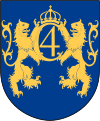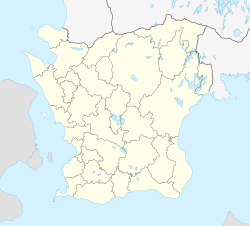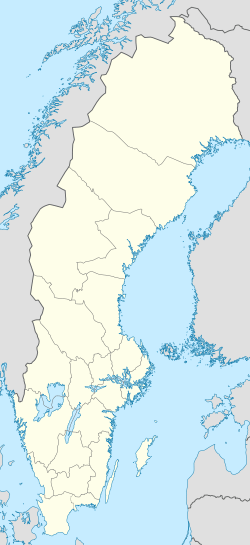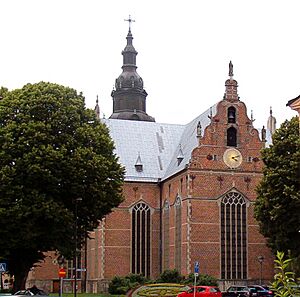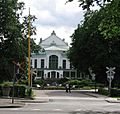Kristianstad facts for kids
Quick facts for kids
Kristianstad
Kristianstads kommun
|
||
|---|---|---|
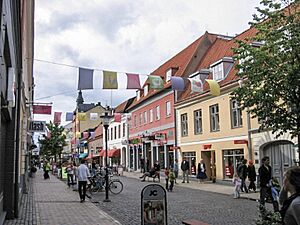
Kristianstad
|
||
|
||
| Country | ||
| Province | ||
| County | ||
| Municipality | Kristianstad Municipality | |
| Area | ||
| • Total | 21.4 km2 (8.3 sq mi) | |
| Population
(31 December 2016)
|
||
| • Total | 40,145 | |
| • Density | 1,876/km2 (4,860/sq mi) | |
| Time zone | UTC+1 (CET) | |
| • Summer (DST) | UTC+2 (CEST) | |
| Website | (in Swedish) | |
Kristianstad is a city in Sweden. It is located in Scania County. In 2016, about 40,145 people lived there.
Over the last 15 years, Kristianstad has changed a lot. It used to be a military town. Now, it is a busy city for business and visitors. Many tourists from Germany, Denmark, and the Netherlands visit in summer.
Contents
History of Kristianstad
How Kristianstad Was Founded
King Christian IV of Denmark founded Kristianstad in 1614. The city's name means 'Town of Christian'. It was a planned city, meaning it was designed before being built.
The king created Kristianstad after a nearby town, Vä, was burned. He moved the city rights (permission to be a city) from Vä and Åhus to the new town.
The main reason for the new city was to protect the eastern part of Scania. This area was then part of Denmark. The king wanted to guard against attacks from Sweden. He also wanted to show his own power.
Early Buildings and Design
Building Kristianstad was a big project for King Christian IV. The city's church is very famous. Many people think it is one of the most beautiful buildings he ever built. Some even call it northern Europe's most beautiful Renaissance church.
The church was built much larger than needed at first. The king also wanted a castle. But there was not enough money. Only an arsenal was built, which is now a museum.
Kristianstad was one of the first places where Renaissance town planning was used. This means the city center is still easy to navigate today.
Kristianstad Becomes Swedish
In 1658, Scania, including Kristianstad, became part of Sweden. This happened after the Treaty of Roskilde. This treaty gave the eastern part of Denmark to Sweden.
Important People and Roles
After 1709, Pylyp Orlyk became a leader for the cossacks. He was in exile and supported by the Swedish king Charles XII. Orlyk wrote one of Europe's first state constitutions.
This Constitution of Pylyp Orlyk was confirmed by King Charles XII. It also called him "the protector of Ukraine." Orlyk and about 40 other Cossacks came to Sweden in 1715. They lived in Kristianstad for several years.
For a long time, Kristianstad was the capital of Kristianstad County. This lasted from 1719 to 1997. Today, it is home to the local government for Skåne Regional Council.
Kristianstad was also a very important military town. Many military units were based here. The Wendes Artillery Regiment fought well in the Napoleonic Wars.

Geography
Lowest Point in Sweden
Kristianstad is special because it has Sweden's lowest point. This spot is 2.41 meters (about 8 feet) below mean sea level.
Because of this, parts of the city need protection from floods. They use levees (walls) and water pumps. To make the city bigger, some low-lying wet areas have been walled off.
Protecting Against Floods
To stop future floods, the existing levees are being made stronger. New levees are also being built along the Helge å river and Hammarsjön lake. A large system of ponds and dams is also being created.
In 2002, a big flood threat happened. Most of the public park, Tivoliparken, was under water.
Kristianstads Vattenrike Biosphere Reserve
The wetlands around the city are now seen as a valuable natural area. This is thanks to the Kristianstads Vattenrike Biosphere Reserve. Today, the Vattenriket is a UNESCO biosphere reserve. This means it is a special place where nature and people live together.
Climate
Kristianstad has a humid continental climate. This means it has warm summers and cold winters. Summers are usually warm and longer than in many other parts of Sweden.
| Climate data for Kristianstad, 2002–2020; extremes since 1901, precipitation 1961–1990 | |||||||||||||
|---|---|---|---|---|---|---|---|---|---|---|---|---|---|
| Month | Jan | Feb | Mar | Apr | May | Jun | Jul | Aug | Sep | Oct | Nov | Dec | Year |
| Record high °C (°F) | 11.6 (52.9) |
15.3 (59.5) |
20.4 (68.7) |
25.6 (78.1) |
29.5 (85.1) |
32.9 (91.2) |
32.9 (91.2) |
33.6 (92.5) |
27.5 (81.5) |
23.5 (74.3) |
17.7 (63.9) |
13.0 (55.4) |
33.6 (92.5) |
| Mean daily maximum °C (°F) | 2.7 (36.9) |
3.4 (38.1) |
7.3 (45.1) |
12.5 (54.5) |
17.6 (63.7) |
21.0 (69.8) |
23.1 (73.6) |
22.2 (72.0) |
18.4 (65.1) |
12.3 (54.1) |
7.6 (45.7) |
4.4 (39.9) |
12.7 (54.9) |
| Daily mean °C (°F) | 0.3 (32.5) |
0.8 (33.4) |
3.2 (37.8) |
7.1 (44.8) |
12.0 (53.6) |
15.5 (59.9) |
17.8 (64.0) |
17.3 (63.1) |
13.6 (56.5) |
8.8 (47.8) |
5.0 (41.0) |
2.0 (35.6) |
8.7 (47.7) |
| Mean daily minimum °C (°F) | −2.2 (28.0) |
−2.0 (28.4) |
−0.9 (30.4) |
1.7 (35.1) |
6.4 (43.5) |
10.0 (50.0) |
12.6 (54.7) |
12.5 (54.5) |
9.0 (48.2) |
5.2 (41.4) |
2.6 (36.7) |
0.0 (32.0) |
4.7 (40.5) |
| Record low °C (°F) | −27.8 (−18.0) |
−23.4 (−10.1) |
−22.8 (−9.0) |
−8.5 (16.7) |
−3.8 (25.2) |
0.2 (32.4) |
4.5 (40.1) |
2.2 (36.0) |
−2.0 (28.4) |
−9.9 (14.2) |
−15.0 (5.0) |
−24.6 (−12.3) |
−27.8 (−18.0) |
| Average precipitation mm (inches) | 47.7 (1.88) |
33.0 (1.30) |
36.2 (1.43) |
36.1 (1.42) |
42.4 (1.67) |
47.4 (1.87) |
64.0 (2.52) |
50.1 (1.97) |
54.8 (2.16) |
50.6 (1.99) |
53.7 (2.11) |
50.7 (2.00) |
561.8 (22.12) |
| Source 1: SMHI Average Precipitation 1961-1990 | |||||||||||||
| Source 2: SMHI Average Data 2002-2016 | |||||||||||||
Environmental Efforts
Kristianstad has made big progress in being environmentally friendly. The city and its nearby areas, with about 80,000 people, now use almost no oil, natural gas, or coal for heating. This is true even during the cold winters.
This is a huge change from 20 years ago. Back then, all their heating came from fossil fuels.
Industry and Education
Local Products
Absolut Vodka is a famous drink made in the town of Åhus, which is part of Kristianstad Municipality.
Many businesses in and around Kristianstad work with agriculture. People often say that every Swede eats something produced from Kristianstad every day.
Military and Schools
Kristianstad was once a major military center in Scania. It had many military camps and training grounds. After military changes in the 1990s, these were closed. However, a new military presence is starting in nearby Rinkaby.
The old military ground is now home to Kristianstad University College (Kristianstad Högskola). This school specializes in training teachers and nurses.
Culture
Film History
The Swedish Film Industry (Svensk Filmindustri) started in Kristianstad in the 1910s. Later, in 1920, it moved to Stockholm.
Today, the old studio is a museum. You can visit Sweden's very first film studio there. It has been kept and restored to look like it did in 1909. The early days of film in Kristianstad helped lead to the success of Swedish film worldwide.
Art Gallery
The Kristianstad Art Gallery is in an old post office building from 1917. It shares an entrance with the Kristianstad Regional Museum.
The gallery opened in 2001. It focuses on showing contemporary art, which means art from our time.
Coat of Arms
The city's coat of arms shows two lions. They are holding King Christian IV's royal symbol, the monogram C4.
The coat of arms changed only a little after Sweden took over in 1658. One reason Sweden kept the old design might be its colors: blue and yellow. These are also Sweden's national colors.
Since 1971, the coat of arms has been used by the Kristianstad Municipality.
Events
World Scout Jamboree
In 2011, Sweden hosted the 22nd World Scout Jamboree. This is a huge international event for Scouts.
About 40,000 participants from 144 countries came. The Jamboree was held at Rinkabyfältet, near Kristianstad.
Åhus Beach Handball Festival
Every summer, a big beach handball tournament takes place in Åhus. Åhus is a seaside town in the municipality.
The Åhus Beach Handball Festival is Europe's largest beach handball tournament. For 10 days, over 1,000 teams and 10,000 players gather on the beach. They compete in this fun sport. The festival started in 1997.
Notable natives
- Magnus Colcord Heurlin Artist Alaska
- Ingeman Arbnor, economist
- Fredrik Böök, author
- Bror Erik Friberg, Judge of Assessment Court, New Zealand, 1877
- Ann-Louise Hanson, singer
- Bo Lundgren, politician
- Emma Lundberg, artist and architect
- Augusta Lundin, fashion designer
- Hulda Lundin, tailor and educator
- Åke Ohlmarks, writer
- Vivi Sylwan, textile historian and curator
- Johan Christopher Toll, soldier
- Carl Ludvig Trägårdh, artist
- Lisa Nordén, professional triathlete, 2008 Olympian and 2012 Olympic silver medalist
- Timothy Liljegren, professional ice hockey player, Toronto Maple Leafs
- Kosovare Asllani, professional football player
- Johan Stureson, racing driver
Sister cities
Kristianstad has eight sister cities around the world:
 Espoo, Finland
Espoo, Finland Køge, Denmark
Køge, Denmark Rendsburg, Germany
Rendsburg, Germany Skagafjörður, Iceland
Skagafjörður, Iceland Budafok, Hungary
Budafok, Hungary Koszalin, Poland
Koszalin, Poland Šiauliai, Lithuania
Šiauliai, Lithuania Kongsberg, Norway
Kongsberg, Norway
Sights
See also
 In Spanish: Kristianstad para niños
In Spanish: Kristianstad para niños


